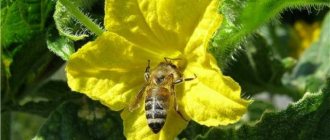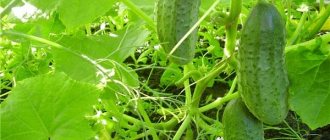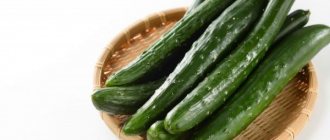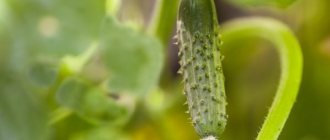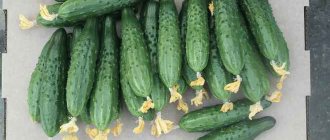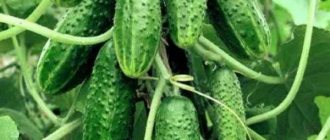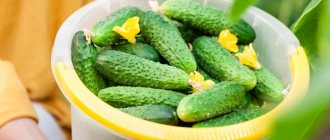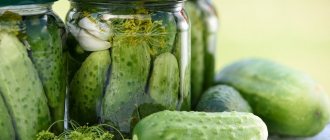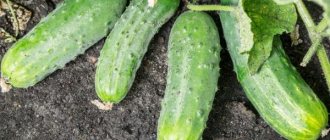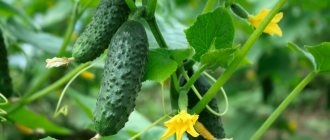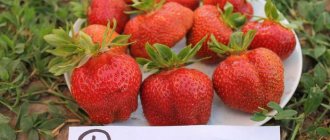Description of cucumbers of the Parisian gherkin variety
The State Register of Breeding Achievements of the Russian Federation defines Parisian Gherkin cucumbers as a variety and recommends it for personal and subsidiary farms in the Central and Central Black Earth regions. Main characteristics of the plant:
- Versatility of cultivation. The variety is recommended for open ground, hotbeds and greenhouses while providing access for insects.
- Early ripeness. The period from germination to the beginning of fruiting is 38–45 days.
- Bee pollination. Unlike most similar varieties, the Parisian gherkin grows more female flowers, but they do not form ovaries on their own. They need insects or humans to transfer pollen from the male flower to the female flower.
- Indeterminate, i.e. constant growth of the stem.
- Growth and branching indicators are average.
- Uniformity of greens. They are small (6–10 cm), fusiform, weighing from 50 to 80 g. They have a green color, small stripes, and large black-thorned tubercles.
- Juiciness of the pulp. It is crispy and medium firm.
- Delicious taste.
- Drought resistance.
- Increased resistance to the main crop diseases: powdery mildew and downy mildew (peronospora).
- High yield: up to 4 kg per square meter. meters of landings.
Small cucumbers of the Parisian gherkin variety are equally good both fresh and canned
To obtain maximum yield, you need to harvest the fruits daily.
If harvested at the wrong time, the fruits do not grow in length, but are barreled
Table: advantages and disadvantages of the variety
| Advantages | Flaws |
| Possibility of growing in open and protected ground, including on the balcony | Barreling of cucumbers due to untimely collection |
| Early high yield | Requirement for soil moisture |
| Duration of fruiting (in greenhouses the last harvest is harvested in October) | Need for support |
| Drought resistance | |
| Fruit uniformity | |
| Excellent taste data | |
| The plant does not need pinching | |
| Versatility of use: can be used in salads, pickled, pickled (when canned, the fruits remain firm) | |
| Resistance to major cucumber diseases | |
| Good transportability |
How to grow vegetables in a greenhouse
The rules for planting this variety of cucumbers in a greenhouse are practically no different from others. You can plant both seeds and seedlings in early May, but for better ventilation and illumination of the vines, the planting density will be less frequent than on ridges - 3-4 cucumbers per 1 m2. Plant in rows or in a checkerboard pattern, whichever is more convenient for you, but always in warm, fertile, breathable soil.
The main problem for a gardener when growing “Parisian gherkins” remains the question: how to pollinate cucumbers without bees in protected ground.
I advise experienced vegetable growers to take care of attracting pollinating assistants into the greenhouse.
This can be done in advance by planting a bush of a honey plant between the cucumbers, for example:
- white mustard, which is also a green manure and a seasoning for sauces and marinades, will prevent the appearance of slugs in the greenhouse;
- matthiola (levy) blooms at the end of June. Nocturnal fragrance attracts pollinators at night and in the morning;
- marigolds will not only attract bees, but will also enrich and neutralize the soil from weeds and protect cucumbers from aphids;
- phacelia emerges in 5-8 days; bees can smell its scent several kilometers away.
The presence of these plants even next to the greenhouse guarantees pollination of cucumber flowers. Just remember to remove faded flowers (before seeds form) from the greenhouse in a timely manner so that they do not turn into weeds.
Feeders with sweet aromatic syrup placed in the greenhouse are a good bait for attracting pollinators. As you can see, the most important condition is to ensure unhindered access for bees, bumblebees, butterflies, beetles and other useful helpers, otherwise the flowers will have to be pollinated by hand.
For the mechanical process, you need to select a male (empty flower) flower, carefully collect the pollen with a dry watercolor brush and pass it along the stigma of the female pistil (with a small cucumber). The viability of the male flower is short-lived - only one day
Even by evening it will wither. It is necessary to have time to collect pollen and fertilize the female pistil during the blooming period of the “barren flower”.
But the female flower lives longer, especially in cloudy weather - up to 3 days, closing in the evening and opening in the morning and awaiting fertilization. After successful pollination, the enlargement of the ovary is noticeable on the 2nd or 3rd day.
In the Parisian Gherkin crop, breeders created more female flowers to increase yield. Pollen from one male can pollinate up to 5 female inflorescences.
Methods for planting cucumbers
Cucumbers of the Parisian gherkin variety can be planted from seeds directly into the ground or grown as seedlings.
Sowing seeds in the ground
It is recommended to sow the beds with glazed, granulated or coated seeds. They are treated with disinfectants and growth stimulants. Each seed is in a nutrient shell containing substances that are necessary for rapid germination. Information about the compositions used for processing is indicated by the manufacturer on the packaging. In this case, seed germination will be 100%; they do not need additional measures.
The shell contains nutrients, microelements, growth regulators, which will ensure normal development of seedlings in the early stages
When determining the timing of sowing in the ground, you need to focus on the condition of the soil. It must be well heated (to a temperature of at least +15 °C). Planting cucumber seeds in cold soil will lead to their death. For the central regions of Russia, it is recommended to plant within the following periods:
- early May - sowing seeds in greenhouses;
- mid-May - to ridges with temporary shelter;
- end of May - on uncovered ridges.
The time for planting seeds may vary depending on the area and weather conditions of the season.
If the seeds are not enclosed in a special shell, then it is recommended to disinfect and germinate them. To disinfect, you need to soak the planting material in a weak saline or manganese solution, and then rinse it with running water.
To disinfect, cucumber seeds are placed in a solution of potassium permanganate (1 g of powder per liter of water) for 20 minutes.
At the same time, you can calibrate the seeds. Those that remained floating on the surface are incomplete and their germination is questionable. For sowing, take only the seeds that have sunk to the bottom of the container. Germination significantly speeds up the process of emergence of seedlings.
- The seeds are laid out between layers of moistened cloth or gauze.
- The material is placed in a container covered with glass or film. This is necessary to reduce moisture evaporation.
- The container is placed in a warm place (25–27 °C).
- After 2–3 days, the seeds will hatch and can be planted in the ground.
Sprouted cucumber seeds sprout vigorously and help to get an early harvest
Sowing is carried out according to a 50x30 cm pattern with a planting depth of 2–3 cm. According to reviews, cucumber seeds of the Parisian gherkin variety show almost 100% germination if the processing conditions are met.
Video: sowing cucumbers in the ground with germinated seeds
Seedling method
The most popular is the seedling method of growing cucumbers. In this case, you must follow certain rules:
- Sowing is carried out only with full-fledged seeds.
- It is recommended to use seeds that have undergone industrial processing or disinfection and soaking in growth activators at home.
- Containers for seedlings should have dimensions of 8–10 cm in diameter and height, as well as high-quality drainage holes.
- A fertile soil mixture is used to fill the planting containers. Basic requirements for it: looseness, nutritional value, lightness, pre-moistening.
The seeds are planted in small pots with a nutritious soil mixture: 1 part small sawdust, 2 parts each humus and peat; per 10 liters of mixture add 1.5 tbsp. l. Nitrophoska and 2 tbsp. l. wood ash
- When sowing, seeds are buried no more than 2 cm.
- For growing seedlings, choose a well-lit place with a temperature range of 22–25 °C.
- The seedlings are planted in the ground after 2–3 true leaves appear on it.
- After planting the seedlings in the ground, water them abundantly, mulch the soil around the plants and give them several days to get used to the new conditions.
Seedlings ready for planting should have strong stems no more than 30 cm high with short internodes, dense leaves of a dark green color, and a developed root system.
Cucumber seedlings should be planted in the ground approximately three weeks after germination.
Following these simple rules will allow you to obtain high-quality seedling material. It should be planted on a warm, well-lit ridge, adhering to the following scheme: 4 plants per 1 square meter. meter.
Cucumber care
To prevent the appearance of pests, it is necessary to carefully care for crops. Loosen the soil, water regularly, remove weeds in a timely manner, pinch out shoots, add fertilizers on time and monitor the condition of the leaves. There are several rules that will allow you to achieve maximum fruit quality.
- You need to water the Parisian gherkin after lunch. When the foliage is just forming, water should be in moderation; after the flowers appear, the amount of watering should be reduced, and as soon as the fruits appear, increase again.
- For watering, you need to use warm water, otherwise you can reduce the plants' immunity and increase the risk of diseases.
- Add fertilizer as a complementary food. Before the fruit appears - once every ten days, twice. Superphosphate fertilizers can be used as fertilizing.
- Tie the cucumber vines to a trellis, this will allow them not to touch the soil and receive more light and air.
The Parisian gherkin is a spreading bushy plant; it has a developed green part, especially the lateral branches. Try not to plant cucumbers too tightly to avoid touching and overlapping areas. Optimal planting frequency: four bushes per square in the open air and three in the greenhouse. The lashes can also be tied up for a more rational distribution of space. In general, the variety is quite unpretentious and easily tolerates all climate changes and temperature changes.
Features of cultivation
Caring for cucumber plantings consists of tying up, following the regime of watering and fertilizing, as well as high-quality pollination.
Tying up
The Parisian gherkin bushes well and has developed side shoots, so without tying it to a support, caring for it will be difficult. In addition, fastening to a trellis helps ensure high-quality ventilation, good illumination of the crop, and reduces contact of the plant with the soil. You should consider the method of tying when the borage height is 40–45 cm. At this time, the plant will have up to 5 true leaves. Delay in solving this problem risks that fast-growing shoots may be damaged, and this will have a bad effect on the quality of the crop.
Photo gallery: ways to garter cucumbers
Two supports are installed on the opposite edges of the bed, a string is stretched between them, to which the twine that goes down is attached
To organize the trellis, you can use a plastic mesh, which will provide the cucumbers with high-quality horizontal and vertical support.
A pole is installed in the center of the circular bed, from which a rope is stretched to each bush
Features of watering and fertilizing
The Parisian gherkin is a rather unpretentious variety, but it needs regular watering and fertilizing. Improper moisture can cause more harm to the plant than good. When carrying out this procedure, you must adhere to the following recommendations:
- Plants should only be watered with warm water and at the roots.
- It is advisable to water in the early morning or evening. Humidification under the scorching rays of the sun can lead to foliage burns, yellowing and drying.
- Immediately after watering, it is recommended to mulch the soil around the plants.
For mulching beds, it is better to choose organic materials: peat, compost, rotted sawdust.
In hot summers, it is useful to plant a strip of shading plants along the perimeter of the cucumber bed. Corn is excellent for these purposes.
Watering rates:
- During the development of shoots and foliage, watering should be moderate (up to 7 liters of water per 1 square meter once every 5 days).
- During flowering and fruiting, the amount of watering increases. At this time, it is advisable to moisturize the cucumbers daily.
It is recommended to fertilize cucumbers before fruiting begins. This must be done twice with a break of two weeks. Fertilizing is carried out using superphosphate, potassium sulfate and urea. 15 g of each component are dissolved in 5 liters of water and poured over 1 square meter. meter of landing area.
Pollination of cucumbers
The Parisian gherkin cucumber variety is naturally pollinated by bees. To attract them, many gardeners spray their plants with sugar syrup.
Bees and other pollinating insects can be attracted by planting calendula, marigolds or nasturtiums next to cucumbers.
In greenhouse conditions or in unfavorable weather conditions, when there are few insects, the ovaries should be pollinated by hand. To carry out artificial pollination, you first need to determine the male and female flowers on the plant. At the base of female flowers there is a small oblong cucumber-shaped process; male flowers do not have it.
The female cucumber flower differs from the male one in that it has an ovary (small cucumber)
The pollination procedure can be carried out in two ways:
- They pick a male flower from the plant and carefully touch it to the female one, making sure that the pistils and stamens touch.
- Using a soft brush or piece of cotton wool, touch first the stamens on the male flower, and then the pistils of the female flower.
Photo gallery: methods of pollinating cucumbers
Bees and other insects are responsible for the natural pollination of cucumbers, carrying pollen from flower to flower on their legs.
Using a brush, pollen from the stamens of a male flower is carefully transferred to the pistils of a female flower.
Pollination can be carried out by bringing a male flower to a female one and lightly touching them
Mark the female flowers that you pollinate. To do this, you can tear off one petal at a time. This will help you not get confused and pollinate all the female ovaries.
Growing cucumbers in a greenhouse
Many gardeners prefer to grow small-fruited cucumbers in a greenhouse. This method is convenient for the Parisian gherkin variety; it pleases vegetable growers with early fruiting and high-quality greens with excellent taste.
Video: features of growing cucumbers in a greenhouse
Harvesting
A bountiful harvest
Cucumbers must be picked from the trellis every day. Otherwise, you may experience deterioration in the quality of subsequent fruits. Some of the most common problems include the following (and how to fix them):
- Zelenets has a pear-shaped shape. This indicates a lack of potassium. In such cases, dilute ash in irrigation water and irrigate all the beds evenly.
- The shape of the fruit resembles an hourglass. This suggests that the difference in daily temperatures was too large. At night, the trellises should be covered with film.
- Arched cucumbers appear when watering is preceded by a period that is too dry.
- Lack of ovaries. Most often occurs due to insufficient pollination. Artificial pollination can be carried out. This is usually done in the morning.
Diseases and pests of cucumbers
The Parisian gherkin variety is resistant to common cucumber diseases, so preventive treatment of the plant with chemicals is not recommended. This allows you to obtain an environmentally friendly product. If signs of diseases do appear on the plants, then you should know about ways to combat them.
Table: treatment of lesions on cucumbers
| Diseases and pests | Signs of defeat | Control and prevention measures |
| Downy mildew (peronospora) |
|
|
| Powdery mildew |
| Treatment with fungicides (according to instructions):
|
| Cucumber mosaic |
|
|
| Bacteriosis |
| Spraying with a 0.5–0.7% solution of Bordeaux mixture |
| Sprout fly | Sprout fly larvae destroy seeds and young shoots of cucumbers. | Treatment with insecticides (according to instructions):
|
| Aphid | Aphids suck the juice from various parts of the cucumber. This can lead to the death of the plant. | Spraying with garlic infusion:
|
Photo gallery: pests and diseases of cucumbers
Downy mildew affects only cucumber leaves, on which yellow-green angular spots form
When affected by bacteriosis, small watery spots first appear on the leaves, which then dry out and turn into ulcers.
In areas affected by powdery mildew, a white coating of mycelium forms, which gradually becomes continuous from individual spots
Sprout fly larvae drill holes in germinating seeds, leading to the death of the sprout
Cucumber leaves affected by cucumber mosaic become covered with white or yellow spots, which gradually increase in size.
Aphids suck juice from leaves, shoots, ovaries and flowers, causing them to wrinkle and curl
Reviews from gardeners
Cucumbers of the famous variety “Parisian Gherkin” are very popular and deserve positive reviews from gardeners. Most often, summer residents use seed material of this variety from such well-known companies as SeDeK. The variety is distinguished by very neat leaves and shoots, miniature cucumbers, which, even when outgrown, are still not very large in size. Cucumbers at the stage of technical maturity reach a length of no more than 10 cm. They are very aromatic, have large pimples, and have an attractive appearance and excellent taste.
